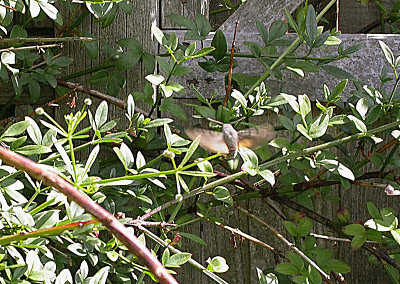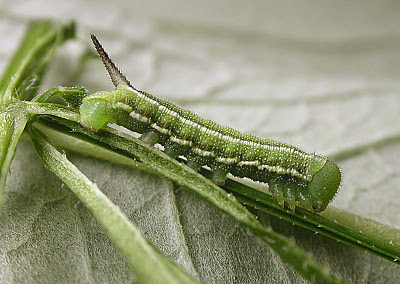69.001 Lime Hawk-moth larva, Calderdale Royal Hospital boundary wall, Sept. 9th 09. Collected by day. Four records of single larvae on the roadside area of this site over two years suggests a reasonably healthy population exists amongst the numerous Common Lime trees present. Also two adults were seen in the same area in the spring of 2014, both resting on walls and probably having just emerged. One was of the orange red form brunnea.
69.001 Lime Hawk-moth male on Apr.17th 2010. Reared from the larva above.
69.001 Lime Hawk-moth of the reddish/brown form brunnea. It came to MV light at Black Brook, Barkisland on May 2nd 2025.
69.002 Eyed Hawk-moth male by the side of the towpath at Elland Bridge, May 16th 07. A field observation in the light drizzle.
69.002 Eyed Hawk-moth male to MV light at the Rush Field at Hardcastle Crags on June 3rd 2023. It was resting in the grass next to the trap.
69.003 Poplar Hawk-moth eggs found on Aspen at Hollin Hall, Hardcastle Craggs on June 15th 2023. Six days later the first larva appears - not so much a hatching but munching its way to freedom!
69.003 Poplar Hawk-moth egg, details above. A close-up of the stemmata which function as simple eyes, seen here as a row of black dots and, those all important jaws.
69.003 Poplar Hawk-moth larva, details above. Having eaten the remains of the egg it pushes out to freedom. The silhouette of the other larva can just be made out.
69.003 Poplar Hawk-moth larva, details above. The hawk-moth horn is now clearly visible - how on earth did that larva fit inside such a small egg?
69.003 Poplar Hawk-moth larva at Tag Loop, Sept. 15th 2012. It was found crossing a path after apparently being blown out of a nearby Crack Willow tree.
To rear the
larva through I placed it in a plastic container which in this case was a clear, 500ml yogurt pot, the bottom was lined with absorbent kitchen roll. Obviously you need to ID
the larva first to find out what it will eat. Provide fresh leaves and remove frass daily. Once it’s fully fed it's last bowel movement will be very loose as it clears itself of waste matter prior to pupation - there will be a noticeable staining of the kitchen roll. It will also become
very restless as it searches for somewhere to pupate.
Now’s the time to
transfer it to a large plant pot two thirds full of slightly moist potting
compost. Put some leaves in just in case it’s still hungry and cover the top
with an old pair of nylon tights secured with an elastic band. If it’s ready to pupate it will quickly burrow down in to the compost.
After
around three weeks the pupal case will have hardened sufficiently to allow safe
removal from the plant pot. I carefully excavate it with an artist’s paintbrush bearing in mind that the pupa will be well camouflaged inside a flimsy outer cocoon constructed from silk and particles of compost which gives it a bit of extra protection from predators.
Next place it on some kitchen roll inside a large Tupperware box. The box then goes in a shaded outhouse for the winter. Just before closing the lid, gently breath on it to add a tiny amount of moisture and then quickly snap it on. Every two weeks or so throughout the winter repeat this process to let fresh air in and also to replenish the moisture. If the box smells when opened the pupa will have died and gone soft and mouldy - fingers crossed this has never happened to any of mine so far!
Come next April bring the pupa indoors and place it a container lined with kitchen roll, the original plant pot will do. Every couple of days very lightly spray the pupa with water using a gardener's mist gun and a week or so before emergence is due pop some nylon over the top to prevent the emerged adult from escaping. It usually takes mine about a month after bringing it indoors for the moth to emerge. The kitchen roll aids the moth to gain a foothold to let it's wings expand or at least it enables it to climb up to the nylon to do so.
Below is the freshly emerged moth still clinging to the nylon that once covered the pot.
Next place it on some kitchen roll inside a large Tupperware box. The box then goes in a shaded outhouse for the winter. Just before closing the lid, gently breath on it to add a tiny amount of moisture and then quickly snap it on. Every two weeks or so throughout the winter repeat this process to let fresh air in and also to replenish the moisture. If the box smells when opened the pupa will have died and gone soft and mouldy - fingers crossed this has never happened to any of mine so far!
Come next April bring the pupa indoors and place it a container lined with kitchen roll, the original plant pot will do. Every couple of days very lightly spray the pupa with water using a gardener's mist gun and a week or so before emergence is due pop some nylon over the top to prevent the emerged adult from escaping. It usually takes mine about a month after bringing it indoors for the moth to emerge. The kitchen roll aids the moth to gain a foothold to let it's wings expand or at least it enables it to climb up to the nylon to do so.
Below is the freshly emerged moth still clinging to the nylon that once covered the pot.
69.003 Poplar Hawk-moth, May 7th 2013. Reared from the larva pictured above. A pristine male with not a scale out of place.
69.003 Poplar Hawk-moth, May 7th 2013. Details above.
69.003 Poplar Hawk-moth to MV light at Clock Face quarry on May 31st 2025. This male had a warmer brown colour than usual.
69.010 Hummingbird Hawk-moth laying eggs in my garden at Skircoat Green, July 2nd 2011. All previous records have been of moths darting about busily feeding on nectar so this one peaked my interest when it remained hovering around a "weed" that wasn't even in flower. You can just make out her abdomen curling underneath the Common Cleaver (Galium aparine) leaves as she deposits her eggs.
69.010 Hummingbird Hawk-moth egg on Common Cleavers. Using the above photo as a guide I managed to locate two eggs, exciting stuff!
69.010 Hummingbird Hawk-moth egg, July 5th 2011. Three days later and the eggs are ready for hatching as they develop darker, cloudy patches. This and the photo below were taken through a microscope eyepiece on 20x.
69.010 Hummingbird Hawk-moth newly hatched larva at 2mm long. Just 4 days after being laid the first egg hatches. Straight away the characteristic hawkmoth horn on the rear end is present.
69.010 Hummingbird Hawk-moth, 3rd instar larva at 12mm long, July 14th 2011.
69.010 Hummingbird Hawk-moth, detail of the larva above.
69.010 Hummingbird Hawk-moth pre-pupal larva, July 23rd 2011. The two larvae have finished feeding and have turned a dull pink and brown. They will soon burrow down in to the earth to spin their cocoons to pupate in.
69.010 Hummingbird Hawk-moth pupa, July 30th 2011. One week later and the pupal case has hardened sufficiently to enable it to be extracted from its earthen cocoon safely.
69.010 Hummingbird Hawk-moth, Aug. 18th 2011. It's just 47 days after the eggs were laid and already both adults have emerged.
It was immensely satisfying to have reared both eggs through and to be able to release the moths back in to the wild.
69.010 Hummingbird Hawk-moth resting on a mill wall next to the towpath just above Elland Bridge, Sept. 30th 2025.
It's unusual to see them at rest like this, usually they're whizzing about erratically and way too fast for my camera's autofocus. It also looked in pristine condition so perhaps it was a local breeder that had just emerged.
69.016 Elephant Hawk-moth larva in my garden at Skircoat Green on July 26th 2014. Found by my mum after weeding out some small willowherbs. She considered the possibility that it may have been a small snake!
69.016 Elephant Hawk-moth, same larva as above. The tiny, grey head and forelegs are easy to miss.
69.016 Elephant Hawk-moth larva, Fall Lane, Sowerby Bridge, Sept. 21st 2010. Collected by day on Rosebay Willowherb. Larvae can be conspicuous as they rest openly by day on their foodplant in August and September.
69.016 Elephant Hawk-moth pupa, Oct. 3rd 2010. Reared from the larva above. It will spend the winter in an outbuilding and be brought in next March.
69.016 Elephant Hawk-moth, Apr. 26th 2011. Reared from the pupa above. It never ceases to amaze me how common these are for such an exotic looking moth.
69.016 Elephant Hawk-moths to MV light at Mirey Wall farm near Sowerby on June 24th 2022. Nicely arranged on Honeysuckle by Sarah Flood.
69.017 Small Elephant Hawk-moth to MV light at Black Brook, Barkisland on May 2nd 2025.





















%202.jpg)













No comments:
Post a Comment